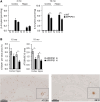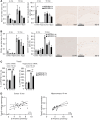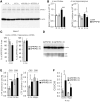Activation of the hypoxia response protects mice from amyloid-β accumulation
- PMID: 35852609
- PMCID: PMC9296391
- DOI: 10.1007/s00018-022-04460-6
Activation of the hypoxia response protects mice from amyloid-β accumulation
Abstract
Alzheimer's disease (AD) is the most common cause of dementia with limited treatment options affecting millions of people and the prevalence increasing with the aging population. The current knowledge on the role of the hypoxia/hypoxia-inducible factor (HIF) in the AD pathology is restricted and controversial. We hypothesized based on benefits of the genetic long-term inactivation of HIF prolyl 4-hydroxylase-2 (HIF-P4H-2) on metabolism, vasculature and inflammatory response that prolonged moderate activation of the hypoxia response could hinder AD pathology. We used an aging model to study potential spontaneous accumulation of amyloid-β (Aβ) in HIF-P4H-2-deficient mice and a transgenic APP/PSEN1 mouse model subjected to prolonged sustained environmental hypoxia (15% O2 for 6 weeks) at two different time points of the disease; at age of 4 and 10 months. In both settings, activation of the hypoxia response reduced brain protein aggregate levels and this associated with higher vascularity. In the senescent HIF-P4H-2-deficient mice metabolic reprogramming also contributed to less protein aggregates while in APP/PSEN1 mice lesser Aβ associated additionally with hypoxia-mediated favorable responses to neuroinflammation and amyloid precursor protein processing. In conclusion, continuous, non-full-scale activation of the HIF pathway appears to mediate protection against neurodegeneration via several mechanisms and should be studied as a treatment option for AD.
Keywords: Alzheimer’s disease; HIF; Hypoxia; Inflammation; Metabolism; Vascularity.
© 2022. The Author(s).
Conflict of interest statement
Financial interests: JMy owns equity in FibroGen, Inc., which develops HIF-P4H inhibitors as therapeutics and supports research in JMy laboratory. The other authors have no relevant financial or non-financial interests to disclose.
Figures









Similar articles
-
Targeting HIF-P4H-2 in APP/PS1 Alzheimer's mouse model improves glucose metabolism, reduces dystrophic neuritis, and maintains exploratory activity.J Biol Chem. 2025 Aug;301(8):110432. doi: 10.1016/j.jbc.2025.110432. Epub 2025 Jul 1. J Biol Chem. 2025. PMID: 40609789 Free PMC article.
-
APP Knock-In Mice Produce E22P-Aβ Exhibiting an Alzheimer's Disease-like Phenotype with Dysregulation of Hypoxia-Inducible Factor Expression.Int J Mol Sci. 2022 Oct 31;23(21):13259. doi: 10.3390/ijms232113259. Int J Mol Sci. 2022. PMID: 36362046 Free PMC article.
-
Intermittent hypoxia therapy ameliorates beta-amyloid pathology via TFEB-mediated autophagy in murine Alzheimer's disease.J Neuroinflammation. 2023 Oct 20;20(1):240. doi: 10.1186/s12974-023-02931-6. J Neuroinflammation. 2023. PMID: 37864249 Free PMC article.
-
Effects of CX3CR1 and Fractalkine Chemokines in Amyloid Beta Clearance and p-Tau Accumulation in Alzheimer's Disease (AD) Rodent Models: Is Fractalkine a Systemic Biomarker for AD?Curr Alzheimer Res. 2016;13(4):403-12. doi: 10.2174/1567205013666151116125714. Curr Alzheimer Res. 2016. PMID: 26567742 Review.
-
APP transgenic modeling of Alzheimer's disease: mechanisms of neurodegeneration and aberrant neurogenesis.Brain Struct Funct. 2010 Mar;214(2-3):111-26. doi: 10.1007/s00429-009-0232-6. Epub 2009 Nov 29. Brain Struct Funct. 2010. PMID: 20091183 Free PMC article. Review.
Cited by
-
Knockdown of microglial iron import gene, DMT1, worsens cognitive function and alters microglial transcriptional landscape in a sex-specific manner in the APP/PS1 model of Alzheimer's disease.Res Sq [Preprint]. 2024 Jun 27:rs.3.rs-4559940. doi: 10.21203/rs.3.rs-4559940/v1. Res Sq. 2024. Update in: J Neuroinflammation. 2024 Sep 27;21(1):238. doi: 10.1186/s12974-024-03238-w. PMID: 38978579 Free PMC article. Updated. Preprint.
-
Targeting HIF-P4H-2 in APP/PS1 Alzheimer's mouse model improves glucose metabolism, reduces dystrophic neuritis, and maintains exploratory activity.J Biol Chem. 2025 Aug;301(8):110432. doi: 10.1016/j.jbc.2025.110432. Epub 2025 Jul 1. J Biol Chem. 2025. PMID: 40609789 Free PMC article.
-
Understanding human aging and the fundamental cell signaling link in age-related diseases: the middle-aging hypovascularity hypoxia hypothesis.Front Aging. 2023 Jun 13;4:1196648. doi: 10.3389/fragi.2023.1196648. eCollection 2023. Front Aging. 2023. PMID: 37384143 Free PMC article.
-
Why Is Iron Deficiency/Anemia Linked to Alzheimer's Disease and Its Comorbidities, and How Is It Prevented?Biomedicines. 2023 Aug 30;11(9):2421. doi: 10.3390/biomedicines11092421. Biomedicines. 2023. PMID: 37760862 Free PMC article. Review.
References
MeSH terms
Substances
Grants and funding
LinkOut - more resources
Full Text Sources
Medical

